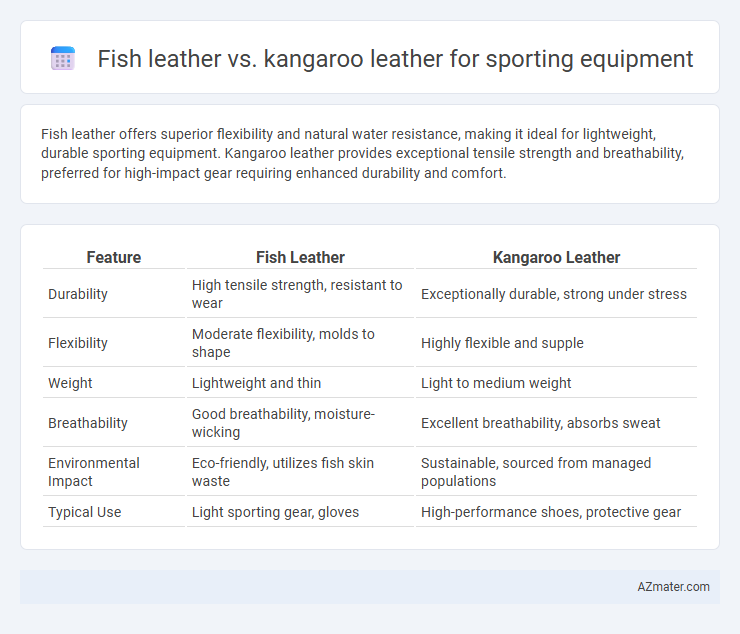Fish leather offers superior flexibility and natural water resistance, making it ideal for lightweight, durable sporting equipment. Kangaroo leather provides exceptional tensile strength and breathability, preferred for high-impact gear requiring enhanced durability and comfort.
Table of Comparison
| Feature | Fish Leather | Kangaroo Leather |
|---|---|---|
| Durability | High tensile strength, resistant to wear | Exceptionally durable, strong under stress |
| Flexibility | Moderate flexibility, molds to shape | Highly flexible and supple |
| Weight | Lightweight and thin | Light to medium weight |
| Breathability | Good breathability, moisture-wicking | Excellent breathability, absorbs sweat |
| Environmental Impact | Eco-friendly, utilizes fish skin waste | Sustainable, sourced from managed populations |
| Typical Use | Light sporting gear, gloves | High-performance shoes, protective gear |
Introduction to Fish Leather and Kangaroo Leather
Fish leather, renowned for its exceptional durability and unique textured patterns, offers a sustainable alternative in sporting equipment manufacturing due to its lightweight and water-resistant properties. Kangaroo leather is favored for its outstanding tensile strength, flexibility, and thin yet robust nature, making it ideal for high-performance sports gear requiring both strength and comfort. Both materials provide distinct advantages, with fish leather excelling in sustainability and aesthetic appeal, while kangaroo leather leads in strength-to-weight ratio and durability.
Unique Properties of Fish Leather
Fish leather offers remarkable durability and flexibility due to its dense collagen fiber structure, making it highly resistant to wear and tear in sporting equipment. Its naturally water-resistant and lightweight properties provide superior comfort and performance compared to traditional kangaroo leather. The distinct scale patterns and ecological sustainability of fish leather also appeal to athletes looking for innovative, environmentally friendly materials.
Unique Properties of Kangaroo Leather
Kangaroo leather is renowned for its exceptional strength-to-weight ratio, making it ideal for high-performance sporting equipment such as football boots and gloves. Its fine grain and superior tensile strength provide durability and flexibility, allowing for enhanced control and comfort during intense physical activity. Unlike fish leather, kangaroo leather maintains consistent performance under repeated stress, ensuring longevity and reliability in demanding sports conditions.
Durability and Strength Comparison
Fish leather, derived from species like salmon or cod, offers remarkable durability with its dense fiber structure, making it resistant to abrasion and water damage, essential for sporting equipment subjected to intense wear. Kangaroo leather is renowned for its exceptional tensile strength and lightweight properties, enabling it to withstand heavy strain without compromising flexibility, ideal for high-performance sports gear. When comparing durability and strength, kangaroo leather typically outperforms fish leather in tensile strength and tear resistance, while fish leather provides superior texture and water resistance.
Flexibility and Comfort in Sporting Equipment
Fish leather offers superior flexibility due to its thin, fibrous structure, making it ideal for sporting equipment requiring high dexterity and lightweight comfort. Kangaroo leather stands out for its unique combination of strength and suppleness, providing excellent durability without compromising comfort during intense physical activities. Both materials deliver exceptional comfort, but fish leather excels in flexible applications while kangaroo leather ensures long-lasting performance with consistent softness.
Environmental Impact and Sustainability
Fish leather, derived from byproducts of the fishing industry, offers a sustainable alternative by minimizing waste and reducing the need for traditional livestock farming, resulting in lower carbon emissions and water usage. Kangaroo leather, sourced from wild populations, is often considered environmentally friendly due to its rapid population growth and minimal land impact compared to cattle, but concerns arise regarding ecosystem balance and ethical hunting practices. Both materials provide eco-friendly options for sporting equipment, with fish leather excelling in waste utilization and kangaroo leather standing out for its efficient land use and biodegradability.
Water Resistance: Fish vs Kangaroo Leather
Fish leather exhibits superior water resistance compared to kangaroo leather due to its dense scale structure, making it ideal for wet conditions in sporting equipment. Kangaroo leather, while durable and flexible, tends to absorb more moisture, which can affect performance and longevity during water exposure. Athletes seeking gear for water-intensive sports often favor fish leather for its natural waterproof properties and quick drying ability.
Cost and Availability for Manufacturers
Fish leather offers a cost-effective alternative to kangaroo leather, benefiting from lower raw material expenses due to abundant fish byproducts from the fishing industry. Kangaroo leather, while prized for its strength and flexibility in sporting equipment, tends to have higher costs and limited availability owing to regulated harvesting and geographical constraints. Manufacturers seeking affordable and sustainable options often prefer fish leather because it is more readily available and supports waste reduction in seafood processing.
Popular Sporting Applications
Fish leather, known for its lightweight and durable qualities, is popular in crafting gloves and protective gear for water sports such as fishing and sailing. Kangaroo leather, renowned for its exceptional tensile strength and flexibility, is widely used in high-performance football boots and motorcycle gloves. Both materials provide distinct advantages in sporting applications requiring a combination of durability, comfort, and precision.
Final Verdict: Which Leather Suits Sporting Equipment Best?
Fish leather offers exceptional durability and water resistance, making it suitable for sports requiring flexibility and moisture management, while kangaroo leather provides superior strength, lightweight properties, and excellent abrasion resistance favored in high-impact sports gear. The choice depends on specific sporting needs, with kangaroo leather preferred for intense contact sports due to its toughness and fish leather ideal for water-related activities because of its natural water repellency. Overall, kangaroo leather suits a broader range of sporting equipment demanding resilience and performance.

Infographic: Fish leather vs Kangaroo leather for Sporting equipment
 azmater.com
azmater.com